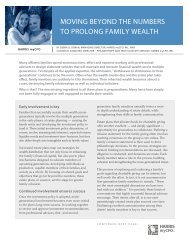The Benefits of Secondary Funds in a Private Equity Portfolio - myCFO
The Benefits of Secondary Funds in a Private Equity Portfolio - myCFO
The Benefits of Secondary Funds in a Private Equity Portfolio - myCFO
You also want an ePaper? Increase the reach of your titles
YUMPU automatically turns print PDFs into web optimized ePapers that Google loves.
Broader scope. Deeper <strong>in</strong>sights.<br />
SECONDARY FUND<br />
PERFORMANCE<br />
As discussed on the previous pages, secondary<br />
funds provide exposure to private equity while<br />
limit<strong>in</strong>g many <strong>of</strong> its <strong>in</strong>herent challenges. While<br />
these mechanical benefits are noteworthy,<br />
performance is what ultimately drives <strong>in</strong>vestor<br />
<strong>in</strong>terest. A look at the historical returns <strong>of</strong><br />
secondary funds reveals their success <strong>in</strong><br />
provid<strong>in</strong>g compell<strong>in</strong>g relative performance.<br />
Historical Returns<br />
From a performance standpo<strong>in</strong>t, secondary<br />
funds have fared well <strong>in</strong> the context <strong>of</strong> the<br />
broader private equity landscape. Accord<strong>in</strong>g to<br />
data from private equity database Preq<strong>in</strong>, s<strong>in</strong>ce<br />
1998 secondary funds have outperformed the<br />
median net IRR <strong>of</strong> the broader private equity<br />
market <strong>in</strong> all but two years (Figure 3). Further,<br />
<strong>in</strong> the years <strong>of</strong> relative underperformance,<br />
it came at a very narrow marg<strong>in</strong>.<br />
<strong>The</strong> same holds true when look<strong>in</strong>g at<br />
performance from a multiple <strong>of</strong> <strong>in</strong>vested capital<br />
(MOIC) perspective, where, with the exception<br />
<strong>of</strong> two v<strong>in</strong>tage years, secondary funds have<br />
outperformed all private equity (Figure 4).<br />
Because secondary funds have the luxury <strong>of</strong><br />
underwrit<strong>in</strong>g a set <strong>of</strong> exist<strong>in</strong>g assets well <strong>in</strong>to<br />
their lifecycle, a degree <strong>of</strong> uncerta<strong>in</strong>ty is removed<br />
from the <strong>in</strong>vestment equation. While the upside<br />
return potential may be limited relative to topquartile<br />
performance <strong>in</strong> buyout or venture capital<br />
strategies, the downside risk <strong>of</strong> secondary funds<br />
is also muted, as evidenced <strong>in</strong> Figure 5 below.<br />
FIGURE 5: SECONDARY FUND VINTAGE YEAR PERFORMANCE LANDSCAPE – NET IRR<br />
% Net IRR<br />
60<br />
50<br />
40<br />
30<br />
20<br />
10<br />
0<br />
-10<br />
-20<br />
1988 1989 1990 1991 1992 1993 1994 1995 1996 1997 1998 1999 2000 2001 2002 2003 2004 2005 2006 2007 2008 2009<br />
Post-2009 v<strong>in</strong>tage years are not <strong>in</strong>cluded as their performance data is not yet mean<strong>in</strong>gful.<br />
Source: Preq<strong>in</strong> - 111 <strong>Secondary</strong> funds report<strong>in</strong>g Net IRR<br />
7



